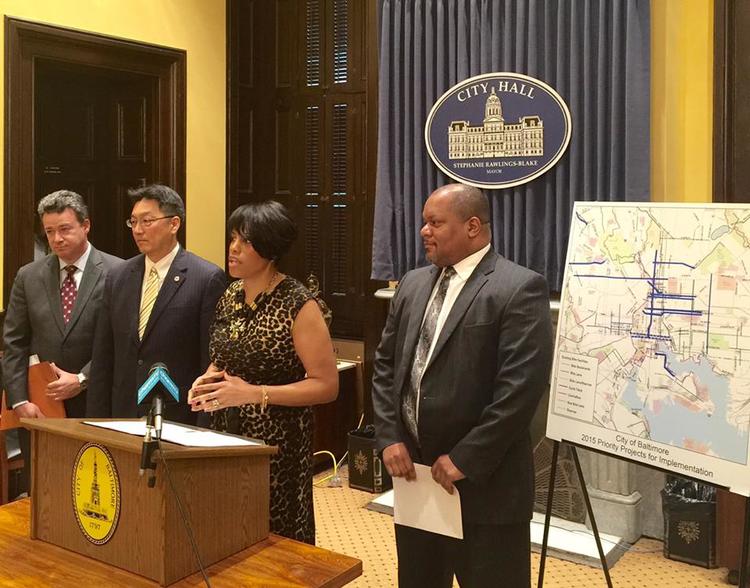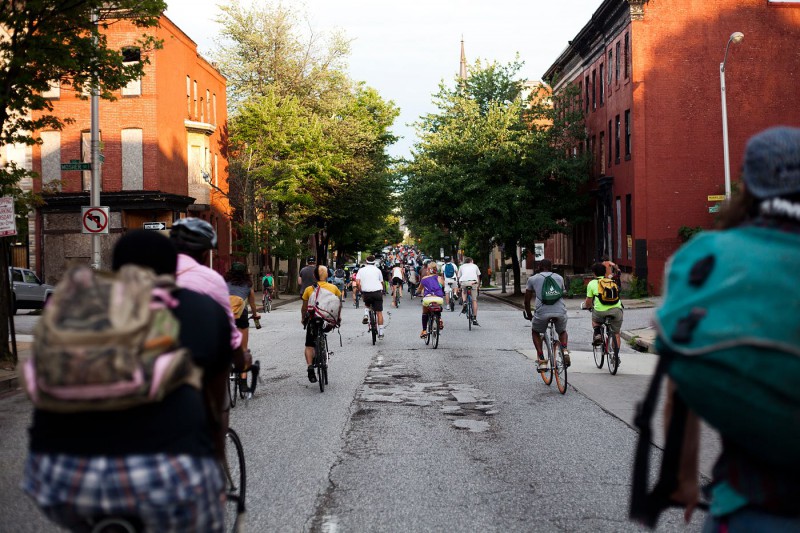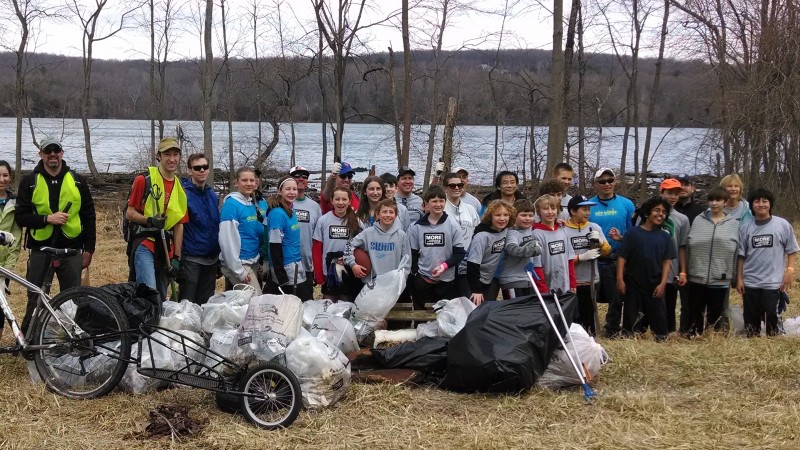
Mayor Stephanie Rawlings-Blake sent the recently updated Baltimore City Bike Master Plan off to the planning commission for a formal vote Thursday, where it is strongly expected to win approval.
The ambitious plan, unveiled online a couple of weeks ago, calls for the addition of roughly 90 miles of new city bike lanes and trails by 2028, including a protected north-south cycle track on Maryland Avenue and a second protected cycle track running east-west in Midtown on Mount Royal Avenue.
Among the other highlights:
—The creation of West Baltimore “bike boulevards” (roads that emphasis safe bicycle access) on Hollins, W. Lexington, W. Baltimore, Carrollton, and N. Smallwood streets
—Bus/bike lane improvements on Pratt and Lombard streets
—The development of a B’More Bicycle-Friendly Business Program
—Implementation of the Charm City Bikeshare by 2016
Other goals include additional bike parking and racks, promoting bicycle safety at schools, bicycling access to the Inner Harbor’s Waterfront Promenade, and mountain bike routes and pump tracks in city parks.
The bigger question at this point, according to bike commuter advocates, is whether the plan will be fully implemented. By all accounts, Baltimore has fallen behind other major cities around the country in recent years—Washington, D.C., New York, Philadelphia, Boston, and Pittsburgh—in building bicycle infrastructure.
Presenting the plan during a media availability Wednesday, Rawlings-Blake said that creating a more bicycle-friendly city is part of her often-stated goal of attracting 10,000 new families to Baltimore. However, neither Rawlings-Blake nor the Department of Transportation committed to an increase in bicycle infrastructure funding. (For what it’s worth, the mayor would not commit to attending Bike to Work Day this year, either, saying only that she’s “thinking about it.”)
Baltimore City DOT director William Johnson said that the city will attempt to fulfill the goals of the plan by leveraging other revenue sources, including federal dollars, and by being “more strategic” in the implementation process, looking at ways to add bike lanes during resurfacing projects, for example. Over the past half-dozen years, dedicated funding for bike network infrastructure in the city has essentially remained flat at roughly $350,000 a year.
“The administration and city council just don’t get it—it’s a quality of life issue that cuts across every socioeconomic demographic,” said Light Street Cycles owner Penny Troutner, who served on the plan’s steering committee, referring to the need to fund implementation of the plan. “Bicycle infrastructure also helps small businesses, because people are more likely to shop at their neighborhood stores when they can bike there, and it helps tourism. Right now, more people aren’t biking because they don’t feel safe.”
In a city with a significant percentage of adults who don’t drive, Troutner noted, bicycling is also one of the least expensive ways to travel to work or school.
At a preliminary unveiling of the new bike plan last month at the Enoch Pratt Free Library, Greg Hinchliffe, interim director of Bikemore, the city’s nonprofit bicycling advocacy organization, said much the same thing as Troutner.
“I think the stuff on the posters [the planned new bikes lanes and trails] looks great, but you can’t ride on pretty lines on the wall,” said Hinchliffe. “The planning looks great; the bottom line is implementation.”

In related news Wednesday, Rawlings-Blake announced an executive order establishing the Mayor’s Bike Advisory Commission, which is intended to help guide the administration and various city departments in promoting bicycling as a safe and convenient transportation and recreation option.
Jon Laria, a partner at the law firm of Ballard Spahr, LLP, and member of the new advisory commission, and also spoke of the need to ensure implementation and necessary funding for the bike master plan now that it’s been completed.
“It’ll be up to us to hold the administration and the city accountable for implementation,” Laria said, adding that he does not yet know how often the advisory commission will meet, but said the meetings will be open to the public.
In welcome news for the mountain biking community, Rawlings-Blake also announced Wednesday that the city has reached an agreement with the Mid-Atlantic Off-Road Enthusiasts (MORE), the regional International Mountain Bicycling Association (IMBA) chapter, to improve mountain bike access around Loch Raven Reservoir.
Access to the best trails in the reservoir watershed has been an area of contention for years between city officials, who have been concerned about maintaining water quality, and local mountain bikers.
From Bikemore’s website:
“Together, DPW (Department of Public Works) and MORE, the regional IMBA (International Mountain Bicycling Association) chapter, will identify specific trails for improvements while closing or re-routing unsanctioned trails … In addition to trail maintenance, MORE and Bike Maryland will conduct education workshops on sustainable trail design and proper mountain biking techniques to reduce user impacts on the area.”
MORE’s annual Project Clean Stream event, which removes debris from Loch Raven Reservoir, is schedule for April 11 in Cockeysville.

